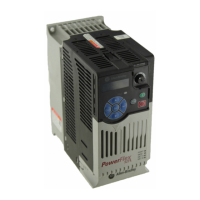Rockwell Automation Publication 520-UM001G-EN-E - September 2014 49
Installation/Wiring Chapter 1
CE Conformity
Compliance with the Low Voltage Directive and Electromagnetic Compatibility
Directive has been demonstrated using harmonized European Norm (EN)
standards published in the Official Journal of the European Communities.
PowerFlex 520-series drives comply with the EN standards listed below when
installed according to the installation instructions in this manual.
CE Declarations of Conformity are available online at:
http://www.rockwellautomation.com/products/certification/
.
Low Voltage Directive (2006/95/EC)
• EN 61800-5-1 Adjustable speed electrical power drive systems – Part 5-1:
Safety requirements – Electrical, thermal and energy.
EMC Directive (2004/108/EC)
• EN 61800-3:2004 +A1:2012 – Adjustable speed electrical power drive
systems - Part 3: EMC requirements and specific test methods
Machinery Directive (2006/42/EC)
• EN ISO 13849-1:2008 – Safety of machinery – Safety related parts of
control systems -Part 1: General principles for design
• EN 62061:2005 – Safety of machinery – Functional safety of safety-
related electrical, electronic and programmable electronic control systems
• EN 60204-1:2006 – Safety of machinery – Electrical equipment of
machines - Part 1: General requirements
• EN 61800-5-2:2007 – Adjustable speed electrical power drive systems -
Part 5-2: Safety requirement – Functional
Refer to Appendix G
for installation consideration related to Machinery
Directive.
General Considerations
• For CE compliance, drives must satisfy installation requirements related to
both EN 61800-5-1 and EN 61800-3 provided in this document.
• PowerFlex 520-series drives must be installed in a pollution degree 1 or 2
environment to be compliant with the CE LV Directive. See Pollution
Degree Ratings According to EN 61800-5-1 on page 49 for descriptions of
each pollution degree rating.
Pollution Degree Ratings According to EN 61800-5-1
Pollution
Degree
Description
1 No pollution or only dry, non-conductive pollution occurs. The pollution has no influence.
2 Normally, only non-conductive pollution occurs. Occasionally, however, a temporary
conductivity caused by condensation is to be expected, when the drive is out of operation.

